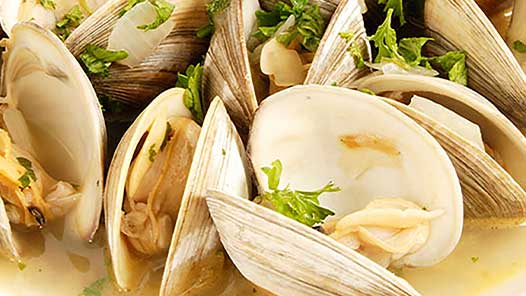
18 Jul Steamed Garlic Clams
If you are a lover of seafood, you may be like Scott Woolley and experiment with recipes at home. It can be difficult to match the recipes that you can get from your favorite restaurant.
One of his favorite recipes is in his latest cookbook, “Cooking For The Family”. That recipe is for steamed garlic clams. This is a long time family favorite.
How to Buy Clams
If you happen to live somewhere that you have access to fresh seafood, that’s great. If your local fresh food market or grocery store has a seafood counter or fish market, the clams should be on ice just loose or in mesh bags.
There should be a tag that indicates the date they were caught. These clams on ice are actually still alive. If they are not, they will grow bacteria quickly, so it is important that you check.
The clams should not have any odor, except maybe the sea. This can be difficult if they are imported from several states away. There should be no cracks or splits in the shells.
Clams with hard shells should be tightly sealed. The soft-shelled clams can not close so make sure they are still fresh by tapping the shell. If it closes, then the clams are still okay. Otherwise, don’t buy them or use them, if they are already home.
Storing Clams
Once you have the clams from the market, don’t leave them sitting around. They should be one of the last perishable things that you buy. Leave their packaging open so the air keeps moving.
Ideally, you should cook the clams the day you buy them. Go through them again, looking for cracks, broken shells, and bad, fishy smells. If you are storing the clams, you should only do so for one day.
Before storing, wash the clams thoroughly. Place them in a solid strainer to let them get completely rinsed. If you have a lot, do them in batches to avoid cracking them, or suffocation.
Don’t let the clam soak in water. Rinse them off, then move the entire strainer to a shallow pan or bowl, cover with a damp towel or paper towel, and then place in the refrigerator. Keep the pooling water from covering the clams.
Cleaning Your Clams
If your clams are coming right out of the ocean, then the cleaning process is a bit more involved than if they are farmed. Most of us are buying farmed clams, so they will not have a lot of sediment.
Scott Woolley recommends that you give them a good scrub on the outside, to get rid of anything that may be on the shells. It also gives you another opportunity to give them another checking over.
You do want to make sure there is no sand or other bits of the ocean floor on them, as freshly harvested clams can attract any amount of debris. To purge the clams, soak the clams in ⅓ of a cup of sea salt or kosher salt in one gallon of cold water, for about 20-30 minutes. Repeat this two or three times.
If there is anything there, it will fall out to the bottom of the bowl or pail. If you are going to soak cultivated or pre-purged hard shell clams, they will only need one soaking, but wild or soft shell clams might need two or three.
When you are done soaking them, remove them carefully with your hand, a smaller screened basket, or a slotted spoon. Never dump the entire thing into the sink, as you can damage them, plus you will just pour the grit back over the clams.
Cooking Your Clams
Follow Scott Woolley’s recipe for his family favorite ‘Steamed Garlic Clams” at www.scottwoolley.com
Clam Fun Facts
Here are a few fun facts about clams that you may not know:
March 31st is National Clams on the Half Shell Day
November 1st is National Deep Fried Clams Day
Clams live for two things: Food and sex. Hence the saying, “Happy as a Clam”
Clams feed year-round, but less in winter because they need less energy
Clams have no brain, so they get no pleasure from food or sex. Not so happy clam
They also have no eyes, ears, or noses, so they cannot see, hear, or smell
A clam that is 2 to 3 inches is more and likely three to five years old
A normal clam can live to about 33 to 36 years old
In 2007, scientists discovered a specimen of the ocean quahog that was between 405 and 410 years old
More Seafood Recipes
Be sure to look through Scott Woolley’s “Cooking for the Family” cookbook for more great recipes for seafood and so much more. It’s full of great recipes, tips, and heartfelt quotes. www.scottwoolley.com



Sorry, the comment form is closed at this time.